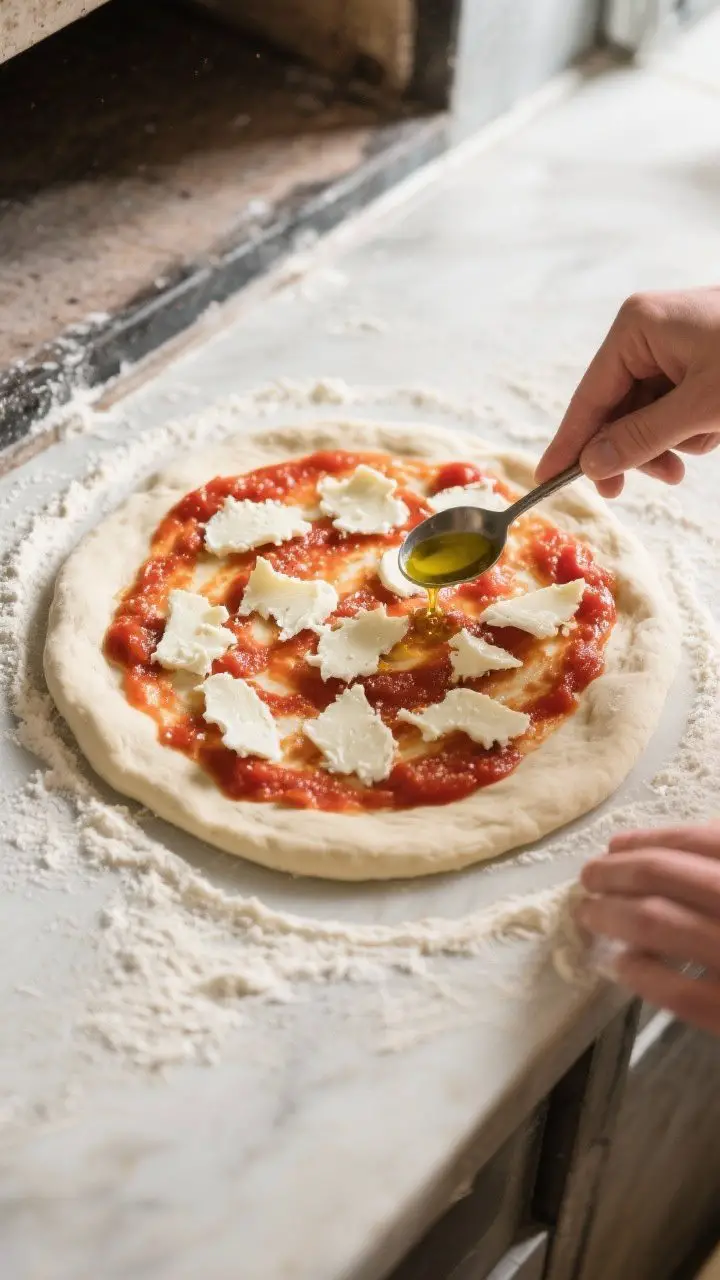Neapolitan Margherita Pizza With Fresh Mozzarella – Simple, Classic, and Flavor-Packed
A great Margherita pizza is all about balance: chewy crust, bright tomato, creamy mozzarella, and fresh basil. It’s simple, but that’s the charm. With just a few quality ingredients and some smart technique, you can bring a bit of Naples to your kitchen.
This version focuses on a thin, tender crust with a puffy rim and a clean, vibrant sauce. No fancy toppings—just the essentials done right.
Why This Recipe Works

This recipe leans on the quality of a few ingredients, not a long list. Fresh mozzarella melts beautifully while keeping a milky, delicate flavor.
📖 Get Access to 50+ Printable Smoothie Recipes Instantly! 🖨️
Boost your health with delicious smoothies! These easy-to-follow printable recipe eBooks are perfect for detoxing, fitness goals, and tasty plant-based living. Available for instant download on Etsy! 🌿✨
A quick, uncooked tomato sauce preserves the brightness of the tomatoes and avoids a heavy, stewed taste. High heat mimics a wood-fired oven, giving you a lightly charred, airy crust. Finally, a long, cold rise builds structure and flavor without extra effort.
What You’ll Need
- 00 flour (or a mix of 00 and bread flour), 3 1/4 cups (about 400 g)
- Water, 1 1/4 cups (300 ml), room temperature
- Instant yeast, 1/2 teaspoon (or 1 teaspoon active dry)
- Fine sea salt, 2 teaspoons
- Extra-virgin olive oil, 1 tablespoon (plus more for brushing)
- Whole peeled San Marzano tomatoes, 1 can (14–15 oz), crushed by hand
- Fresh mozzarella (ideally fior di latte or buffalo), 8–10 oz, drained and torn
- Fresh basil leaves, a handful
- Fine semolina or flour for dusting
- Optional: pinch of sugar if tomatoes are very acidic; pinch of salt for the sauce
Tools: Pizza stone or steel, pizza peel (or inverted baking sheet), large bowl, clean kitchen towel or plastic wrap, paper towels, and a baking tray for draining cheese.
How to Make It

- Make the dough. In a large bowl, mix flour and salt.
In a separate cup, combine water and yeast until dissolved. Pour wet into dry and stir until a shaggy dough forms. Add olive oil and knead by hand 5–7 minutes until smooth and elastic.
The dough should be soft and slightly tacky, not sticky.
- Let it rest and rise. Cover and rest at room temp for 20 minutes. Then give it a quick fold (stretch the dough and fold it over itself). Shape into a ball, place in a lightly oiled bowl, cover, and refrigerate 18–24 hours for a slow rise.
If you’re short on time, let it rise at room temp until doubled (about 1–2 hours), but flavor and texture will be better with the cold rise.
- Divide and warm up. Remove the dough from the fridge 60–90 minutes before baking. Divide into two balls for two 10–12 inch pizzas. Cover and let them relax until puffy and easy to stretch.
- Prepare the sauce. Crush the tomatoes by hand in a bowl.
Add a pinch of salt and, if needed, a tiny pinch of sugar. Do not cook the sauce—Neapolitan style is fresh and raw, which keeps it bright and tangy.
- Drain the mozzarella. Tear into bite-size pieces and place on paper towels to wick moisture. Press gently on top with more paper towels.
This step helps prevent a soggy center.
- Heat the oven properly. Place a stone or steel on the top third rack. Preheat to the highest temperature your oven allows (500–550°F / 260–290°C) for at least 45 minutes. A hot surface is key to puff and char.
- Stretch the dough. Dust your work surface and hands with flour or semolina.
Flatten a dough ball from the center out, leaving a slightly thicker edge. Lift and stretch over your knuckles, rotating gently, until it’s 10–12 inches across. Avoid a rolling pin, which can push out needed air.
- Assemble lightly. Transfer the dough to a floured peel.
Spread 2–3 tablespoons of sauce in a thin layer, leaving a small border. Scatter mozzarella evenly. Drizzle with a teaspoon of olive oil.
Less is more here.
- Bake until blistered. Slide onto the hot stone/steel. Bake 6–8 minutes, or until the crust is puffed with charred spots and cheese is melted with slight browning. Turn the pizza halfway if your oven has hot spots.
- Finish with basil. Add fresh basil leaves right out of the oven so they wilt from the residual heat.
A light drizzle of olive oil and a pinch of salt on top makes it sing.
- Repeat with the second dough ball. Work quickly to keep the stone hot and the dough easy to handle.
How to Store
Leftovers: Cool completely, then store slices in an airtight container in the fridge for up to 3 days. Reheat on a hot skillet or in a 450°F oven for 5–7 minutes to revive the crust. Avoid the microwave if you care about texture.
Dough: After the cold rise, dough balls can be lightly oiled, wrapped, and refrigerated up to 48 hours more, or frozen up to 1 month.
Thaw frozen dough overnight in the fridge, then bring to room temp before stretching.
Sauce: Unused crushed tomatoes keep 3–4 days in the fridge. Freeze in small portions for convenient future pizzas.

Health Benefits
- Balanced macronutrients: You get carbohydrates from the crust, protein and fat from mozzarella, and antioxidants from tomatoes and olive oil.
- Lycopene in tomatoes: The tomato base is rich in lycopene, linked with heart health and reduced inflammation.
- High-quality fats: Extra-virgin olive oil provides monounsaturated fats that support cardiovascular health.
- Portion control: A lighter, Neapolitan-style pizza is thinner and less cheese-heavy than many takeout versions, making it a sensible choice.
Pitfalls to Watch Out For
- Wet cheese, soggy center: Not draining fresh mozzarella leads to puddles. Pat it dry and don’t overload.
- Too much sauce: A thin layer is enough.
Excess sauce prevents proper browning and makes the middle floppy.
- Underheating the oven: If the stone or steel isn’t ripping hot, the crust won’t puff. Preheat longer than you think.
- Overworking the dough: Rough handling knocks out gas and tightens gluten, making stretching tough. Be gentle.
- Thick edge of raw dough: If the rim is too thick, it can brown outside but stay gummy inside.
Stretch evenly and bake fully.
Alternatives
- Flour swap: If you can’t find 00 flour, use bread flour for chew. For a softer bite, blend bread flour with all-purpose.
- Yeast options: Active dry yeast works; bloom it in lukewarm water first. Instant yeast can go straight into the flour.
- No stone or steel: Use an inverted baking sheet preheated in the oven.
It won’t char as deeply, but it still crisps the base.
- Buffalo vs. fior di latte: Buffalo mozzarella is richer and wetter; drain it extra well and tear into smaller pieces.
- Grill method: Heat a covered grill to high with a pizza stone. The smoky char is excellent and close to wood-fired results.
- Gluten-free path: Use a high-quality gluten-free pizza flour blend and follow the same method, adjusting water as needed.
FAQ
Can I make the dough the same day?
Yes. Let it rise at room temperature until doubled, about 1–2 hours, then divide, rest, and stretch.
The crust will be good, but a 24-hour cold ferment adds better flavor and texture.
Why is my pizza sticking to the peel?
Use a light, even layer of flour or semolina on the peel. Work quickly once you add toppings. If it sticks, lift an edge and blow a little air under or add a pinch more flour to free it.
Do I need to cook the tomato sauce?
No.
Traditional Neapolitan pizza uses uncooked tomatoes. The high heat cooks the sauce just enough on the pizza, keeping the flavor fresh and bright.
How do I get those leopard spots on the crust?
A super-hot surface is essential. Preheat a stone or steel for at least 45 minutes at the highest oven setting, and use well-hydrated dough.
Avoid overloading toppings, which cools the dough.
What’s the best way to reheat slices?
A hot skillet or oven revives the crust. Heat a dry cast-iron or nonstick pan over medium and cook until the bottom is crisp and the cheese melts, or bake at 450°F for a few minutes.
Can I add garlic or oregano?
For a classic Margherita, keep it minimal. If you like, add a tiny pinch of dried oregano to the sauce or rub a cut clove of garlic on the crust before topping.
Keep it subtle so basil and mozzarella lead.
Is fresh basil added before or after baking?
Add it right after baking so it wilts gently and stays fragrant. If you bake it from the start, it can turn dark and lose aroma.
What if my dough keeps snapping back when I stretch?
It needs more rest. Cover and let it relax for 10–15 minutes, then try again.
A relaxed dough stretches thin without tearing.
Final Thoughts
Neapolitan Margherita pizza rewards patience and restraint. With a slow-rise dough, a hot surface, and just a few quality ingredients, you’ll get a crisp-yet-tender crust and clean flavors that feel timeless. Keep the toppings light, drain your mozzarella, and trust the heat to do the rest.
Once you make it this way, you’ll see why the simplest pizzas often taste the best.





